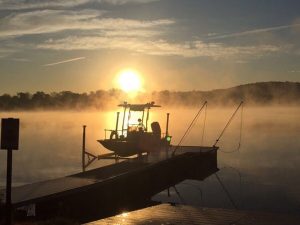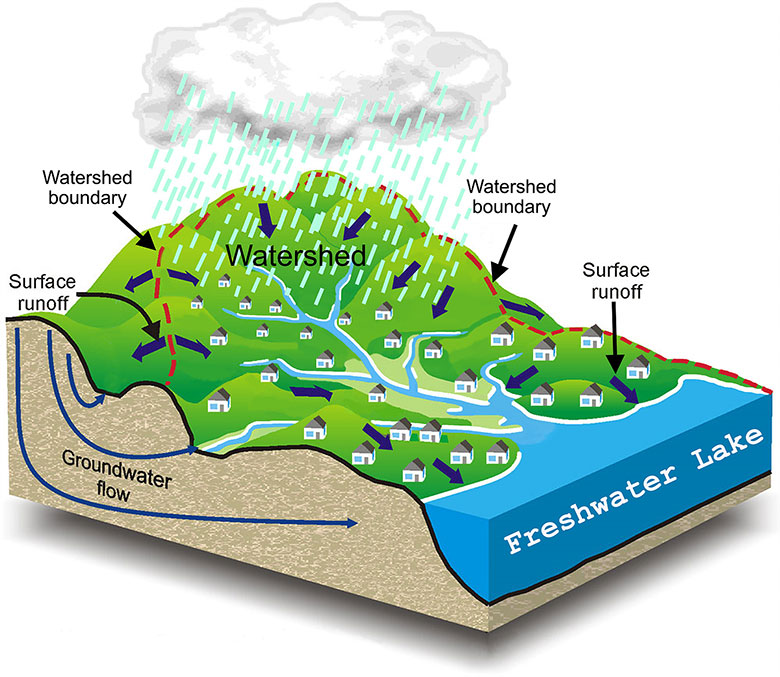A Healthy Lake
Lake Friendly Living Tips
- Do not bathe or wash objects in or near the lake – especially with toxic cleaners, soaps or phosphorous containing detergents.
- Don’t feed the geese or ducks as their waste contains nutrients that support the growth of aquatic weeds and algae.
- Pick up your pet waste – like fertilizers, the nutrients from pet waste can wash into storm drains, streams and the lake after it rains, not to mention the bacteria and other pathogens found in pet waste!
- Take your car to a car wash. If you must wash your car or boat yourself, do not wash it on an impervious driveway. Instead, wash it over the lawn, away from the lake, so the ground can absorb more of the phosphorous and/or chemicals.
- Recycle or properly dispose of household chemicals, waste and harmful vehicular fluids so they don’t end up in our lake.
- Maintain trees and bushes, which serve as filters, intact near the lake.
- Do not put lawn clippings or leaves in the lake and, if possible, remove leaves from the lakebed in the fall. Be sure to mention this to your lawn service.
- Clear storm drains of debris/leaves near your house.
- Divert runoff from boat launches or other lake entries.

Property Design
There are many things you can do to make your property lake friendly. Storm water runoff contributes to excessive aquatic growth and algae blooms, decreased water clarity and shoreline erosion. Storm water carries with it nutrients from fertilizers, pesticides and sediment among other things. Water can build in both volume and speed as it runs downhill, causing further erosion. Properly dealing with and trying to prevent storm water runoff are important lake protection measures.

- Create Buffers – A buffer, or “riparian buffer,” is a strip of land (with vegetation such as plants, shrubs and trees) along the shoreline separating your lawn from the water. This strip of land helps to stabilize the shoreline and prevent erosion while catching runoff from your lawn. It will help to absorb things such as fertilizers and pesticides and trap sediment before it can enter the lake. In addition, it also provides habitat for birds and other small wildlife while acting as a barrier to nuisance Canada geese who may fear a predatory animal is hiding in there.
- Install Rain Gardens/Rain Barrels – A rain garden is a depression in the ground, filled with plants and shrubs, that acts to catch runoff from rooftop downspouts, driveways, etc. The depression fills with the water, so it doesn’t run down the property, and the water is absorbed into the soil and used by the plants. A rain barrel would also collect rooftop runoff from downspouts; however, rain barrels collect and hold the water for such things as gardening and watering other yard plants.
- Reduce Impervious Surfaces – Impervious surfaces such as rooftops, asphalt driveways and sidewalks don’t absorb storm water. Instead, it runs down those surfaces, building in speed and volume. Reducing the amount and effects from impervious surfaces is important. One such way is to reduce the overall impervious surface totals on one’s property. Replacing an asphalt driveway or cement walkway with a more porous surface, such as block or crushed stone, is one such method.
- Less Lawn, More Native Plants – Replace lawn with native plant, shrub and tree cover on your property. Their roots help to stabilize the soil, preventing erosion, and they help to filter runoff of nutrients and sediment before it enters streams, storm drains and the lake. Additionally, native plants, shrubs, trees and grasses are better suited to the conditions found in Connecticut and can survive without needing additional water or a lot of inputs such as fertilizer.
- Ensure Proper Lot Drainage – By adding culverts, diversions, ditches, sump pumps, etc., where necessary, you can help to prevent erosion and encourage infiltration of runoff into soil.
- Utilize Twisting, Narrow Paths – Long straight paths and walkways that lead down a hill (and especially towards the lake) act as direct water chutes into the lake, carrying nutrients, sediment and debris with the water. By creating a narrow, twisting path, the water won’t have a straight run into the lake and instead it will encourage infiltration of the runoff into the soil.
Watershed Management
The following is a summary. For a more specific plan for Highland Lake, click on Highland Lake Watershed Association Lake Management Plan.
Preserving the Waterbodies
The watershed of a lake or other waterbody is that land area which drains toward the water. The watershed is the source of water for the lakes, streams, and ponds within its boundaries. The quality of the water in these bodies of water is largely determined by the materials carried over the land surface, by underground water, and by tributary streams.
Water entering Highland Lake carries nutrients which fertilize the lake and promote the growth of aquatic plants and algae. Particles of sand and other materials also flow off the watershed into the lake and settle to the bottom as sediments. Sediments make the lake shallower, reduce the water’s oxygen, and generally cause the water to decline in quality.


Phosphorous and nitrogen are the two most important nutrients which wash off the watershed into the lake. They cause weeds and algae to grow, which reduces the clarity of the water, may cause odors, affects the fish population, and are a nuisance to people who fish, boat, or swim in the water. The amount of oxygen affects the lake’s ability to keep fish alive and is used to help decompose aquatic weeds.
Watershed management is largely concerned with the amount of phosphorous, nitrogen, and sediment which is washed off the watershed into the waterbodies it surrounds.
If we work together, we can prevent damage to the watershed. Prevention and conservation are usually much less costly approaches to watershed management than restoration. Land that has been misused through such actions as removing all trees from an area (clear cutting), streams and rivers which have had chemicals or other wastes dumped into them, and lakes which have had severe erosion wash nutrients and sediments into them usually have to be restored, if possible.
We ask for your cooperation in using this guide to do whatever you can to help preserve our watershed.

